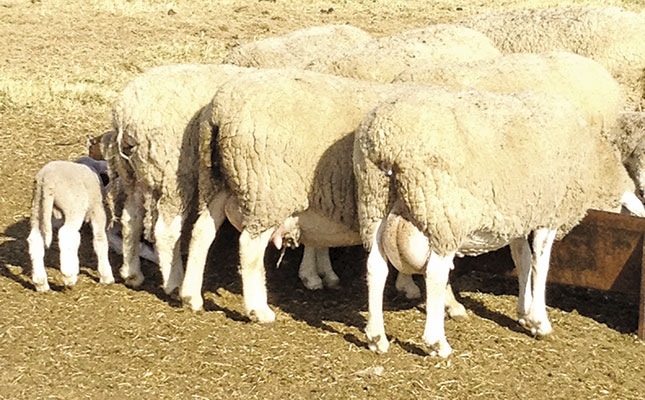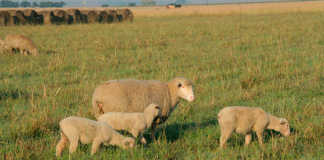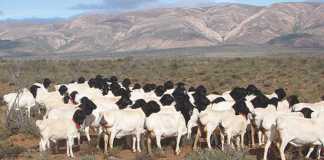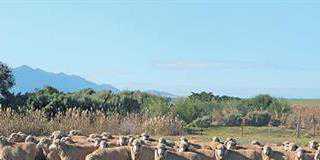
Following a holistic nutritional management programme throughout the ewe’s production cycle ensures a high lambing percentage and frequency. A ewe’s production year can be divided into four distinct critical periods. A ewe is mated during a mating season of about three to six weeks, followed by a gestation period of 153 days (depending on breed) and a lactation period of up to 120 days. During the short dry period after weaning her lamb, the ewe must be prepared for the coming mating season.
With an accelerated mating system (three lambing seasons in two years), the typical ewe calendar becomes more complicated: mating, gestation, lactation and the dry period must all be fitted into an eight-month period. As sheep are seasonal breeders and are most fertile in autumn, timing the mating season is crucial. However, the amount of forage available during the lactation period and at weaning usually dictates the mating season. If the imposed mating season does not coincide with the ewe’s natural mating period, teaser rams or synchronisation may be necessary.
Mating season
From a nutritional point of view, the mating season is the first crucial period. The ewe flock’s condition and lambing percentage are positively correlated. The ovulation rate of the ewe (number of ova released) is controlled genetically and determines her potential (or maximum) fecundity.
The extent to which the ewe will reach this genetic potential depends on the environment, with nutrition being the most important factor. For this reason, the practice of flush feeding ewes before and during the mating season to improve fecundity has become standard on many sheep farms.
Successful flush feeding relies on a good quality feed, which should generally result in a higher nutritional level than that provided by the ewe’s normal diet. The ewe must be in relatively good body condition to respond to the flush feed: fat or under-condition ewes do not respond to flush feeding.
The flush feeding period should ideally cover two oestrogenic cycles (minimum of 17 days each) and start three weeks before the mating season. Ewes should not be over-fed during this period. To reduce flush feeding costs, group ewes according to their condition when weaning their lambs and feed them accordingly.
Gestation
When the ewe has conceived, divide the gestation period into early gestation, mid-gestation and late gestation. The first two periods require little additional nutrients, as relatively good quality forage will provide all the nutrition needed for embryo implantation and development of the placenta and associated structures.
The late gestation period (months four and five of pregnancy) is the crucial nutritional period and places a high demand on the ewe; nutrition must cater for foetus growth and udder development, while preparing the ewe for the coming lactation period.
As nutrition during this period is a highly researched field, there are sound recommendations for feeding high quality natural protein that supplies undegradable protein (‘bypass’ protein), additional energy, and micro-elements to balance any forage limitation. A large proportion of lamb mortality at birth or within the first 48 hours is due to the ewe’s nutritional management during late gestation.
Birth weight
Lamb birth weight is also related to ewe nutrition. Lambs should weigh between 3,5kg to 5,5kg for optimal vigour and survival. Ewes should be grouped according to stage of pregnancy and fecundity. They should be allocated the best pasture possible to sustain foetus and udder development for high colostrum production shortly before parturition, and high milk production during lactation.
The ewe’s nutrient requirement is high and some loss of condition is normal during this stage. Additional energy and ‘bypass’ protein will limit condition loss and support the development of the foetus, resulting in strong, healthy lambs due to good quality colostrum. ‘Bypass’ protein also supports the ewe’s immune system and limits the effect of endoparasites during this stressful period.
In addition to quality protein and energy, a good lick or supplement fed to a late gestating ewe supplies sufficient Vitamin A and Vitamin E, as well as micro-elements such as Zn, Cu, Mn, Se, I and Co. The final advantage of supplementary feeding during late gestation is that the ewe is properly adapted to a high-concentrate diet from lambing onwards.
As soon as the ewe has lambed, she moves into a negative energy balance and needs sufficient body reserves to sustain the high demand for milk production. She must be allocated the best possible grazing and receive greater amounts of the same lick as fed during late gestation.
The protein composition of this lick is crucial, as the ‘bypass’ protein component stimulates the effective utilisation of the ewe’s own fat reserves. This is the most efficient way to produce sufficient colostrum and milk. Lamb survival is strongly correlated to maternal ability and the bond between the ewe and the lamb. Good nutrition supports this, while high milk production supports rapid lamb growth. Using complete feed for lactating ewes in modern, intensive production systems is becoming popular due to its benefits for lamb development and growth, and reduced mortality.
Regaining condition
The dry period in the ewe’s production cycle is sometimes neglected. Depending on the production system and the weaning age of lambs, the ewe may have to reconceive within a month. She has to regain body condition to reconceive and maintain a high lambing rate. This period is too short to efficiently achieve this production target. Nutrition should therefore maintain the ewe’s body condition within the range of 2,5 (at peak lactation) to 3,5 (at mating) during the entire production cycle and avoid great variation in condition.
Phone Dr Francois van de Vyver on 032 439 5879 or email [email protected].













